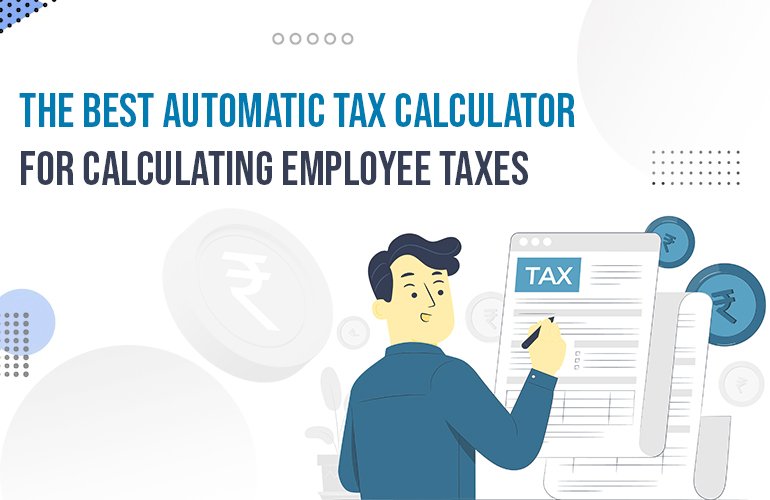Using an Employee Tax Calculator to Understand the Tax Calculation Process
An automatic employee tax calculator can simplify the procedure significantly. You can save time, decrease errors, and assure compliance.

Payroll management may be a difficult chore for any organization. The HR department confronts numerous challenges, particularly when it comes to computing employee taxes.
With so many tax laws and regulations to follow, it's easy to make mistakes or overlook deductions that could result in penalties and fines for your company.
Fortunately, an automatic employee tax calculator can simplify the procedure significantly. Businesses can save time, decrease errors, and assure compliance with tax rules by automating tax computations and delivering correct reports.
Employers in India are required to deduct taxes from their employees' salaries and pay them to the government. The Income Tax is computed based on several factors, including the employee's wage, tax deductions, and other allowances.
Understanding the Indian Tax Calculation Process
The Income Tax Act of 1961 oversees the tax calculation procedure in India. Employers must withhold and pay monthly taxes from their employee's salaries.
The employee's wage, tax deductions, and other allowances determine the tax deducted. The tax calculating procedure is broken into two parts:
- Calculating the taxable income
- Applying the tax rate to determine the amount of tax to be deducted
Calculating the Taxable Income
The first step in calculating taxes is determining the employee's taxable income. This is accomplished by totaling the various components of the employee's income, such as base wage, allowances, and perquisites.
The basic salary is the monthly fixed component of an employee's remuneration. On the other hand, allowances are payments made to employees to cover work-related expenses such as travel and housing.
After determining the overall salary amount, certain deductions are made to arrive at the taxable income. Among these deductions are the following:
Standard Deduction
The government introduced a standard deduction of Rs. 50,000 for salaried individuals in the 2019-20 budget. This deduction is available to all employees, regardless of compensation.
Professional Tax
This is a tax levied by the state government on salaried individuals.
Provident Fund
Employers are required to deduct a certain percentage of the employee's salary and contribute it to a Provident Fund. Employee contribution to the Provident Fund is also deducted from their salary.
Other Deductions
This includes deductions such as health insurance, life insurance, and investments made under Section 80C of the Income Tax Act.
Once these deductions have been made, the taxable income can be calculated.
Applying the Tax Rate
After determining the taxable income, the tax rate can be used to calculate the amount of tax deducted. The employee's income determines the tax rate and might change yearly.
Tax rates in India are separated into multiple slabs. Individual tax rates for the fiscal year 2023-24 are as follows:
- Individuals earning up to Rs. 2.5 lakhs are exempt from paying tax.
- Individuals earning between Rs. 2.5 lakhs and Rs. 3 lakhs are exempt from paying tax.
- Individuals earning between Rs. 3 lakhs and Rs. 6 lakhs must pay 5% tax.
- Individuals earning between Rs. 6 lakhs and nine lakhs must pay 10% tax.
- Individuals earning between Rs.9 lakhs and 12 lakhs must pay 15% tax.
- Individuals earning between Rs.12 lakhs and Rs.15 lakhs must pay 20% tax.
- Individuals earning more than Rs. 15 lakhs must pay 30% tax.
How an Automatic Employee Tax Calculator Works
An automatic employee tax calculator is a software program that automates the tax computation process, decreasing the possibility of errors and ensuring tax law compliance.
These solutions are often coupled with payroll software, allowing them to access employee data and calculate taxes based on the most recent tax rates and rules.
The company inserts the employee's pay information, including gross salary, pay frequency, and any additional earnings, such as bonuses or commissions, into an automatic employee tax calculator.
The calculator automatically estimates income tax based on the employee's investment disclosures and current tax rates. It also considers any unique deductions or exemptions.
When the computations are finished, the program creates a full report showing the employee's net pay, the amounts withdrawn for each form of tax, and any deductions or contributions made.
The Next Steps
Employee tax calculators are beneficial tools for organizations of all sizes since they aid in tax compliance and streamline the process of generating required tax-related documentation.
Businesses can simplify the process of calculating employee taxes and generating relevant tax-related paperwork with a single click by integrating an employee tax calculator into an HR software system.
Thus, implementing a robust employee tax calculator can help your business save time and resources while assuring your company's tax compliance.
Click Here to Visit
What's Your Reaction?





















